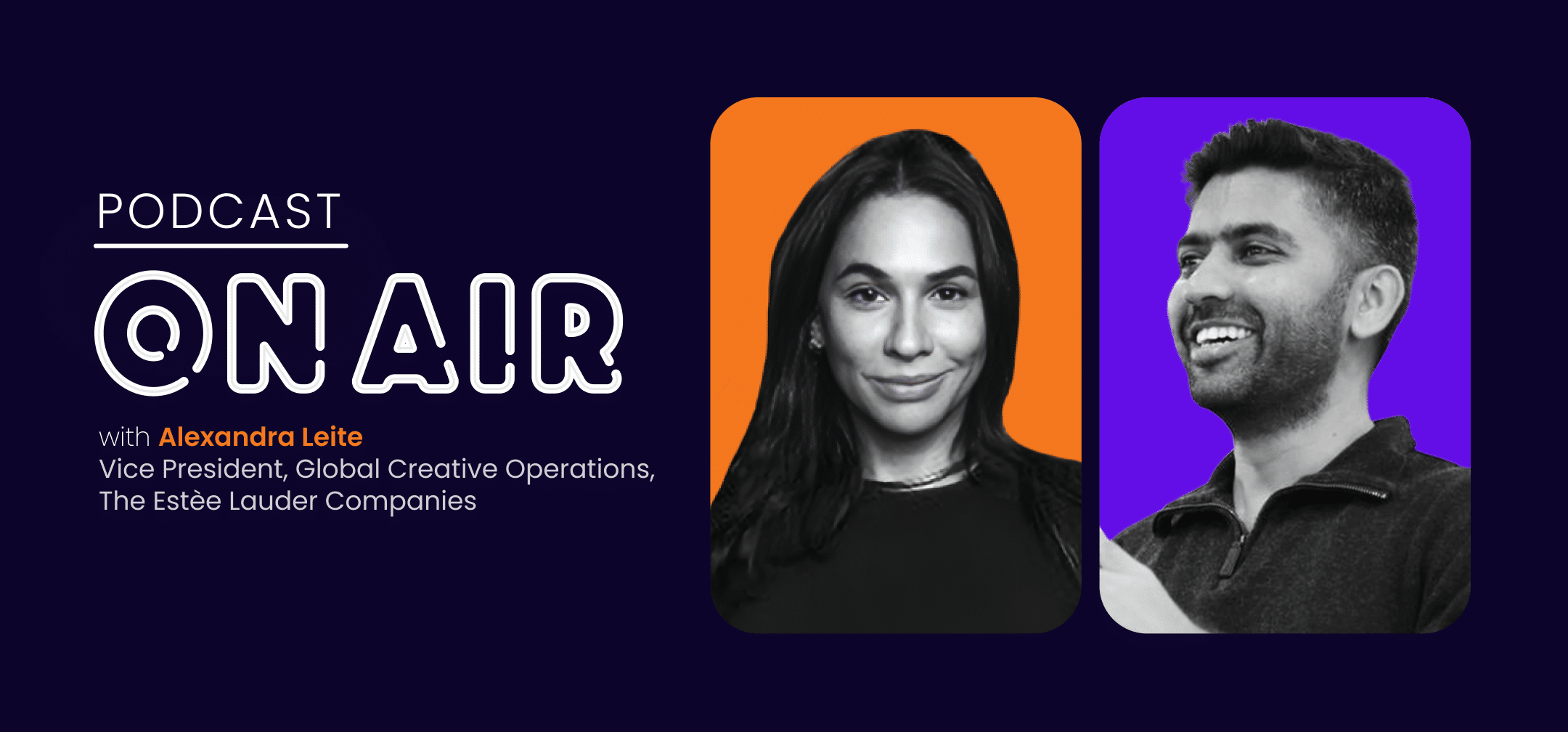
Alexandra Leite, a CreativeOps leader, shares with Rocketium her valuable insights on building a successful and sustainable CreativeOps model. Alexandra has been consistently working with dynamic and motivated teams to drive operational success for businesses. In this episode, she speaks on a wide range of factors that determine the success of a CreativeOps strategy, including AI.
Karan Rao, SVP of Business, Rocketium is back with this week’s guest “On Air with Rocketium” a video podcast that offers a practical take on everything CreativeOps.
Karan: Hello, I’m Karan Rao, and I am happy to welcome you to our latest episode of “OnAir with Rocketium”! Today, we have with us Alexandra Leite from Estée Lauder. Alexandra is a veteran leader of creative operations for the fashion and grooming industry. With over 15 years of experience leading dynamic, cross-functional teams toward proven results, Alexandra exemplifies excellence and efficiency. At present, she’s the Vice President of Creative Operations at The Estée Lauder Companies Inc. and leads three creative operations teams for renowned brands La Mer, Bobbi Brown, and Aveda.
Thanks, Alexandra, for joining us. We’re thrilled to get insights from your extensive creative operations experience.
Alexandra: Thanks, Karan. This is my first podcast and I love it.
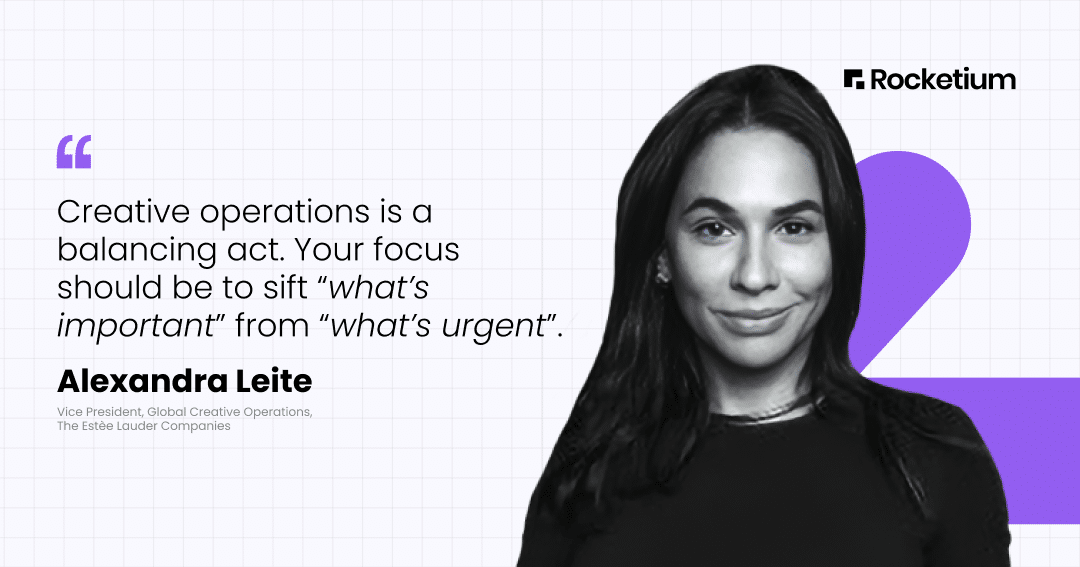
Karan: For starters, why don’t you walk us through your exciting CreativeOps journey over the years?
Alexandra: I started my career as a journalist in Brazil at a time when the Internet had just arrived. I remember one of my friends advising at that time, “You’re such a good journalist; don’t waste your career on this thing—the Internet — it’s going to be a fad.”
Well, they were all wrong. My career with the internet led me to Yahoo! When they first launched in Brazil, I was the first editor for the Yahoo! front page. This was a completely different time when there was no Google, Facebook, or Instagram.
From Yahoo! to New York advertising and now creative operations.
Karan: That’s very cool. Can you walk us through what your day-to-day and team look like in your current role as VP of Global Creative Operations?
Alexandra: I would say that my day-to-day is full of fires. It’s like a raging engine. What I try to do in the long run is to focus on the big-impact things so that I’m not consumed by the fires.
So creative operations, in my opinion, are successful when you can find a balance between two things:
Karan: I think this is one of the best answers I’ve heard for creative operations because everyone talks about the process and not the balance to handle critical parts of your business— like you said, fighting fires. You’ll always have requests coming your way on how to balance that with certain long-term initiatives to be able to partner with the business on the right things. I think that’s the perfect answer.
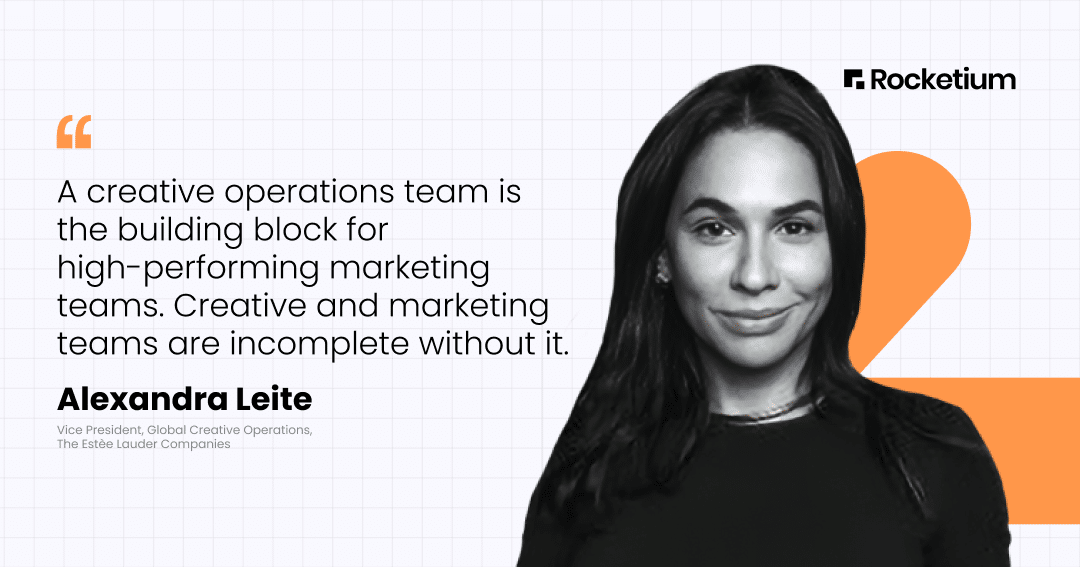
Karan: Can you elaborate a bit on this: let’s say a young organization is starting out. If we consider CreativeOps as an organization that can partner with businesses—especially marketing and branding teams, when do you think it becomes relevant? And also, if you had to set one up, what would the structure of that creative operations organization look like?
Alexandra: I don’t think any high-performance creative team in a high-performance marketing organization can exist without a high-performance creative operations team. The creative operations team is the engine and the enabler of those two areas. I see myself and my team score drivers for creative excellence; how we partner with marketing teams will vary based on the company setup.
At least in my organization, we certainly are one of the building blocks of marketing, and act as a bridge between consumer marketing, product marketing, and our entire creative team.
By ‘bridge’ I mean bridging the differences in different touchpoints of a program lifecycle. I would say that one of the most important moments is the briefing time when a marketer is looking at consumer insights or product positioning and coming to creative. The CreativeOps person has a huge role in ensuring that the brief is relevant and inspirational for our creative team.
So, when we are behind closed doors, we can be the voice of the marketing team in the room and help explain:
Should the marketing team believe this to be a problem? I don’t think so. Since we are the first step in making a creative team understand, and then respond to the bridge the right way.
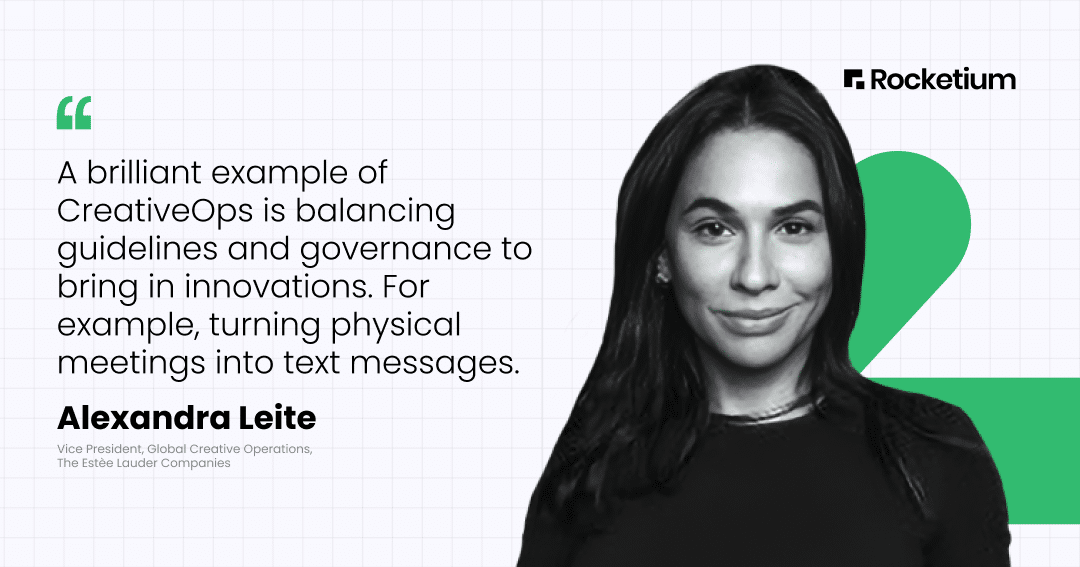
Karan: You have built high-performing teams across various roles in your organizations. Can you share examples of some innovative CreativeOps campaigns that have improved processes for your organizations?
Alexandra: Well, we have so many examples. But, you know, I’m not a stickler for processes. I mean more than the power of processes, I believe more in the power of people working together to build something. Yes, I do follow processes for creating guidelines. However, I can veer away from processes if I feel the work will benefit from it.
Coming back to your question. Let’s say I’m working on a high-level campaign in China that requires a faster go-to-market (GTM) approach instead of a global one. So, instead of working on a campaign that will take a year, I can be working on one that’ll take six months.
The first thing I’ll do is break my process into smaller and time-saving parts. I will take all those meetings and turn them into WeChat or text messages. We usually review each of our campaigns with our creative directors multiple times before vetting it by our Chief Marketing Officer (CMO) and our brand president. Imagine if instead of a meeting, we shifted its contents to an online message. Isn’t that a faster and more innovative process?
This is the problem we’re trying to solve. We already have the guidelines. We mold the governance to make processes more flexible, time-saving, and innovative.
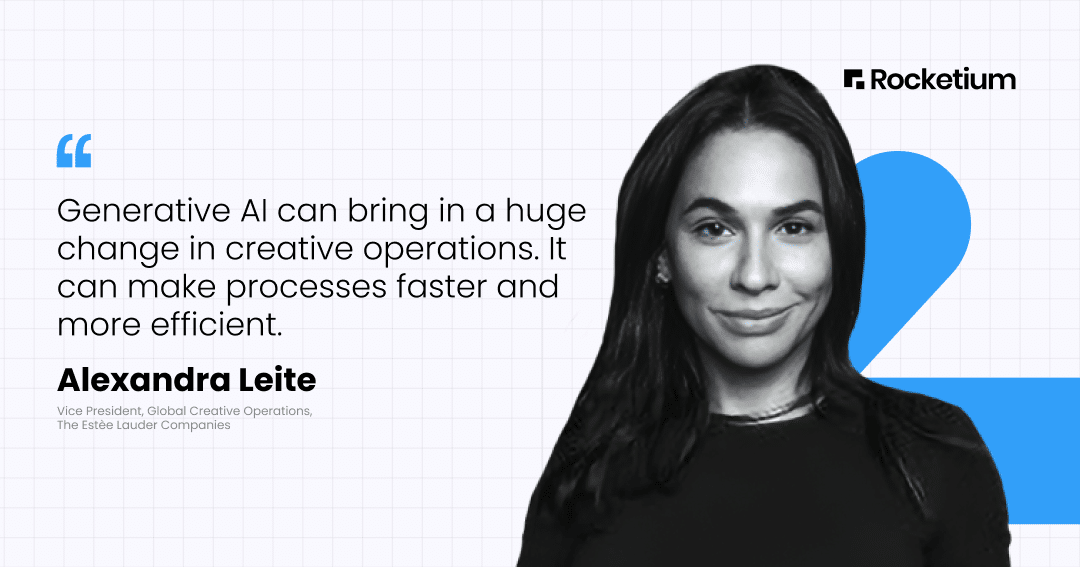
Karan: How do you feel about generative AI? Are there any specific initiatives that you have found success with?
Alexandra: You can’t talk about innovation without talking about the experimentations that the whole creative community is making, at the moment, with AI, automation, and rethinking the old norms on how to get to a final product.
I love how decentralized everything feels. If you think about any innovation that has happened in creative operations in the last couple of years, it has become a lot more top-down.
Like one day, our Chief Information Officer (CIO) or President said, “We’ve got to be responsive, we’ve got to be on mobile, and we’ve got to do this with AI.” And our creative team surprised us by already using it. Like you have known it can take a designer days to create an image. One day you wake up and they’re already creating it on Midjourney through prompts and bringing it to you much faster. There’s a feeling of grassroots coming up that I find extremely exciting.
So, our approach to it has been to keep on experimenting and seeing what works. We can always bring in governance later. For now, we like to let our teams play and tap into generative AI’s potential.
Karan: And that’s amazing because, on one side, you’re talking about governance. On the other side, it’s about enabling your teams to actually run those experiments so that whatever is working can get into the governance framework and then continuously improve your processes.
Alexandra: Absolutely. I don’t think it’s top-down anymore. I don’t think all the executives in a company are going to be able to keep up with the technologies that are flourishing every day. So, if you have both—a leadership team to tell you which enterprise solutions to focus on and a creative team that experiments—it’s a win-win. When you let your creative team experiment with new software to bring their ideas to life, you can explore new and unknown frontiers of creativity.
Karan: Design is so personal to a brand. In our creative audits for various organizations, we have found that the design process takes a lot of time and back and forth. How do you avoid that and decide who’ll be involved in the decision-making process?
Alexandra: I agree branding is a key goal for any brand, irrespective of whether you’re luxury or mass. Everyone wants to stick to what’s wise and working. What can we do as a company to stay unique? In the high end of luxury, that’s a much more controlled approach.
Take any of the fashion houses as an example. They will ensure that the customer has a uniform experience at every single touchpoint. However, more prestige brands sometimes don’t have the same luxury. They need to play much more into the lower funnel, allowing their markets and their regions to achieve local and global relevance differently.
I would say the role, then, of a global brand is to make sure it’s updating its strategy accordingly. It’s creating more and more toolkits and guardrails so that when local markets want to activate campaigns; they know where to play, they know where the sandbox is. Can they explore? Yes, but they should know what not to touch—I call it the ‘Untouchables’.
What are the brand cues that should never disappear? That’s the job of a CMO. That’s the job of a Chief Creative Officer. That’s the balance that we need to achieve between brand equity and commercialization.
Karan: Got it. So, somewhere you’re trying to build the guardrails globally and ensure that they have been established and communicated. And to ensure that you’re competitive in local markets, it’s important to get a little bit of flexibility to commercialize that content, but at the same time stay true to the brand equity.
Alexandra: Yeah. This changes over time and from brand to brand. You look at examples such as Nike, which has one of the most modern marketing in the world. They’ve sometimes done more controlling, sometimes more decentralized. We are the same. Brands evolve with culture, and sometimes more control is necessary, and sometimes more decentralization is necessary.
I think nobody knows what’s the true recipe for success.
There’s also the Apple model, right? It’s completely different. And everybody else, they are doing most of their assets globally. They don’t like social media and they just release it. They’re machines. Nike, at the moment, does a lot of global campaigns, releases, and guidelines, and then they have hundreds of local agencies working under those guidelines.
So I think that’s a model that is very successful for them.
Karan: What would you say are your top priorities, like things that keep you up at night?
Alexandra:I think the idea of a growth mindset is very common, which is what I try to have. So, I believe there are always ways of making things better. Some people believe if it’s not broken, don’t fix it. I actually believe that sometimes it’s not going to be about fixing; sometimes it’s going to be about reinventing.
I liked it when I joined my current organization, I brought in a lot of innovation by making all our systems digitized. At that time, people were still talking about job jackets for their projects. They were printing everything, even Excel sheets. They were printing entire creative work and bringing it to a CMO, even though it meant printing page after page.
And this was just eight years ago. Of course, I created digitized routing systems. I implemented digital tools for managing our timelines. But, I was also living in an era where I was too dependent on manual updates. I’m changing all of this right now. I’m working with a company called Our Table, which is helping me bring all my systems to a database so that I’m able to read my data differently.
Those are all business operations information that helps me become a better creative operations leader. Just two years ago, I was doing everything on an Excel end-to-end to run those reports.
I want them to take less time and become a daily dashboard instead.
Karan: I can imagine having access to this data means so much better capacity utilization, right? Because if you’re running an ops engine, it requires a lot to ensure that the resources are deployed productively and can partner well with the business.
Anything that comes on top of your mind in terms of organization fixes or priorities that keep you up at night?
Alexandra: I think the idea of smart ops is my drive. I don’t want to be known in my organization as the person who runs the timelines, but as the person who brings change to the business and impacts others differently. Sometimes it’s going to be about making better creative work; sometimes it’s going to be about establishing new ways of working.
You know, I’m not using the word process on purpose because I can’t be governed by process. I need to be driven by what type of work generates growth for my company. And the process is just an enabler of that. The last thing, which is normally where I start, is the people.
If I need to redo my process every year because I’m enabling growth from the business and my creative team, that’s the job. So my job is not predefined.
Karan: Interesting. We’ve covered a lot of ground, Alexandra. Before closing, would you like to share any tips and tricks or parting thoughts with our listeners?
Alexandra: I’d like to point out something that I have today that other creative ops teams may not at the moment: a leadership that believes in the power of creative operations. So, if you’re listening and you’re at the beginning of your career or an executive at your company, make sure that you’re connecting with your leaders in a way that they understand what your team does, what you do, and what you are building.
There’s a lot of work that we do behind closed doors and I don’t think we’re talking enough about our value. I try to do that every year where I’m proving the value of what I’m bringing. That’s not invisible. And if I’m proving my value, I’m sitting in rooms where normally operations would not be invited to; and now, I’m part of decision-making in other areas of the company.
So don’t be shy to tell everyone else about the savings from efficiencies you have brought to the organization.
Karan: So moving from operations to more business partnering and having the right executive alignment. Lovely. Alexandra, this was a lovely candid chat. Thank you for spilling the beans on some insider innovation on ops. Some of the candid answers you gave have been extremely helpful for me as well as for our listeners.
Thanks again so much for taking the time. I hope to continue this chat.
Alexandra: Thank you. Karan. It was a true pleasure.